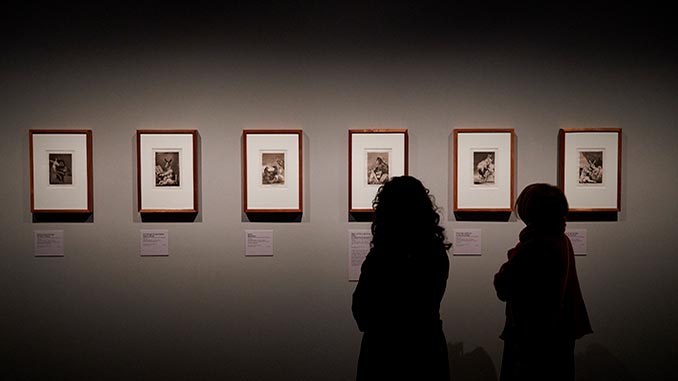 The world-exclusive exhibition Goya: Drawings from the Prado Museum features more than 160 works on paper by Francisco Goya (1746 – 1828), celebrating the artist’s extraordinary draughtsmanship and imagination.
The world-exclusive exhibition Goya: Drawings from the Prado Museum features more than 160 works on paper by Francisco Goya (1746 – 1828), celebrating the artist’s extraordinary draughtsmanship and imagination.
Considered to be one of the first truly modern artists, Goya produced humorous and critical images of Spanish society that comment on gender relationships, social inequality and violence, as well as visions of fantastic creatures.
Goya: Drawings from the Prado Museum is the first major presentation of Goya’s work at the NGV in more than 20 years and features 44 drawings on loan from the Prado Museum, the largest group of Goya’s drawings ever seen in Australia. Ranging from bold ink drawings to delicate red chalk sketches, the drawings on display have been selected by the Prado especially for this NGV presentation.
Highlights include examples from the artist’s earliest albums of social satires, preparatory drawings for his iconic print series, through to pages from the late albums, which contain some of Goya’s most complex and surreal images. This rich and diverse selection of drawings showcases the breadth of Goya’s drawing practice, as well as offering a rare insight into the artist’s image-making process.
Following a near-fatal illness in 1792, which left him profoundly deaf, Goya turned to drawing to record his private thoughts, visions and dreams, and continued this practice until the end of his life. In eight private albums, as well as in single sheet drawings, he gave expression to a vision of humanity that had no equivalent in the art of his day.
Highlight works include This is how useful men usually end up 1814-23, a moving commentary on the consequences of poverty and war, and Literate animal 1824-28, a satirical image of an educated animal, which Goya drew in the last years of his life.
The works drawn from the Prado collection will be complemented by more than 120 etchings from Goya’s renowned print series: the Caprichos 1797-98, which satirised vices and follies in Spanish society; The Disasters of War 1810–15, based on the atrocities of the war and famine that followed the Napoleonic invasion of Spain in 1808; Tauromaquia 1815-16 on the subject of bullfighting; and the enigmatic Disparates c. 1815–19, made during the reign of Ferdinand VII, whose suppression of civil liberties affected the lives of many intellectuals and reformers, including Goya and his friends.
The prints are drawn from the NGV Collection with fifteen works on loan from the Art Gallery of South Australia. Goya’s most famous etching, The sleep of reason produces monsters, a striking composition of the sleeping artist haunted by monstrous apparitions, is also featured in the exhibition.
The exhibition is structured chronologically and thematically around recurring themes in Goya’s art, many of which are as relevant today as they were in Goya’s time: the relationship between men and women; the condemnation of ignorance and religious zeal; the exploration of violence and its consequences; and the device of the nightmare or dream to critique social and political realities.
“All aspects of society came under Goya’s critical eye – from education and marriage, to social justice and power relationships,” said Tony Ellwood AM, Director of the National Gallery of Victoria. “Audiences to this exhibition will be astonished by the contemporary relevance of this exhibition and the universal themes that underpin the works of this celebrated Spanish artist.”
“The NGV has a longstanding relationship with the Prado Museum in Madrid, a cultural partnership which has resulted in the Melbourne Winter Masterpieces exhibition Italian Masterpieces from Spain’s Royal Court, as well as the NGV’s commitment to sharing its significant collection of William Blake watercolours with Spanish audiences in the near future.”
“We are indebted to the Prado Museum for generously lending these important Goya drawings. Without their continued support and commitment to this cultural exchange between Europe and Australia, a presentation of this significance would not be possible,” said Mr Ellwood.
Francisco Goya (1746-1828) was the most celebrated artist of his time in Spain. He was court painter to four monarchs, and lived through the turbulent events of the French occupation, the subsequent Peninsular War, and the Inquisition.
He moved in elite circles and painted portraits of statesmen, aristocrats, influential writers and intellectuals. His friendships with liberals sharpened Goya’s political awareness and social conscience, which was particularly evident in his drawings and prints.
Goya: Drawings from the Prado Museum
NGV International, 180 St Kilda Road, Melbourne
Exhibition continues to 3 October 2021
Entry fees apply
For more information, visit: www.ngv.vic.gov.au for details.
Image: Installation view of Goya: Drawings from the Prado Museum at NGV International, Melbourne – photo by Eugene Hyland
